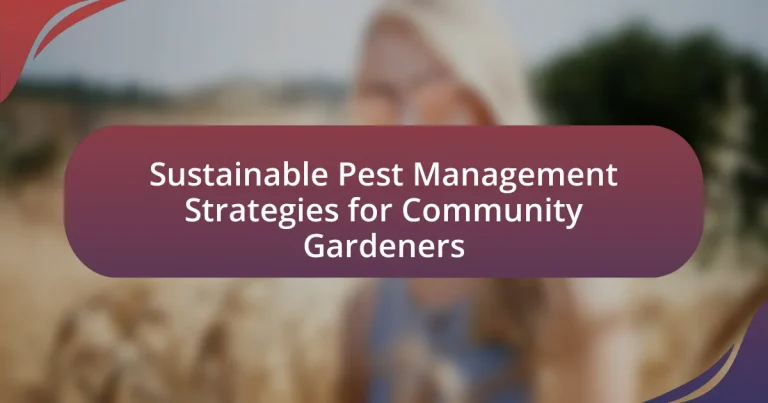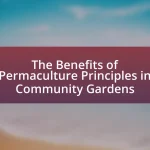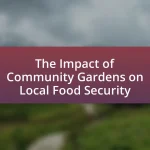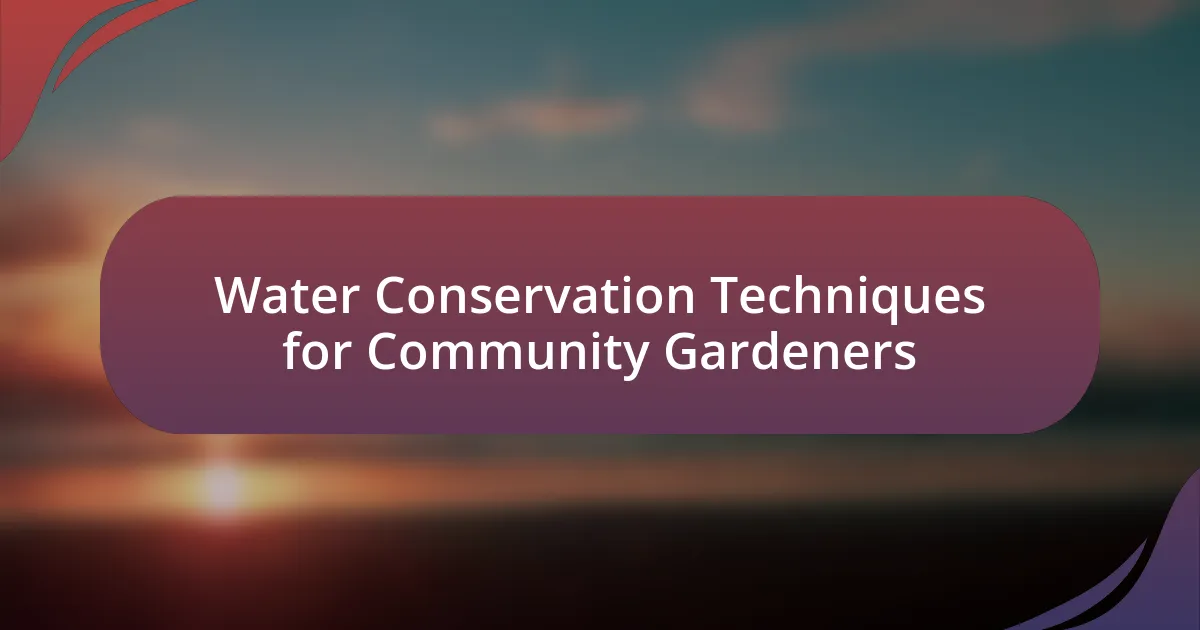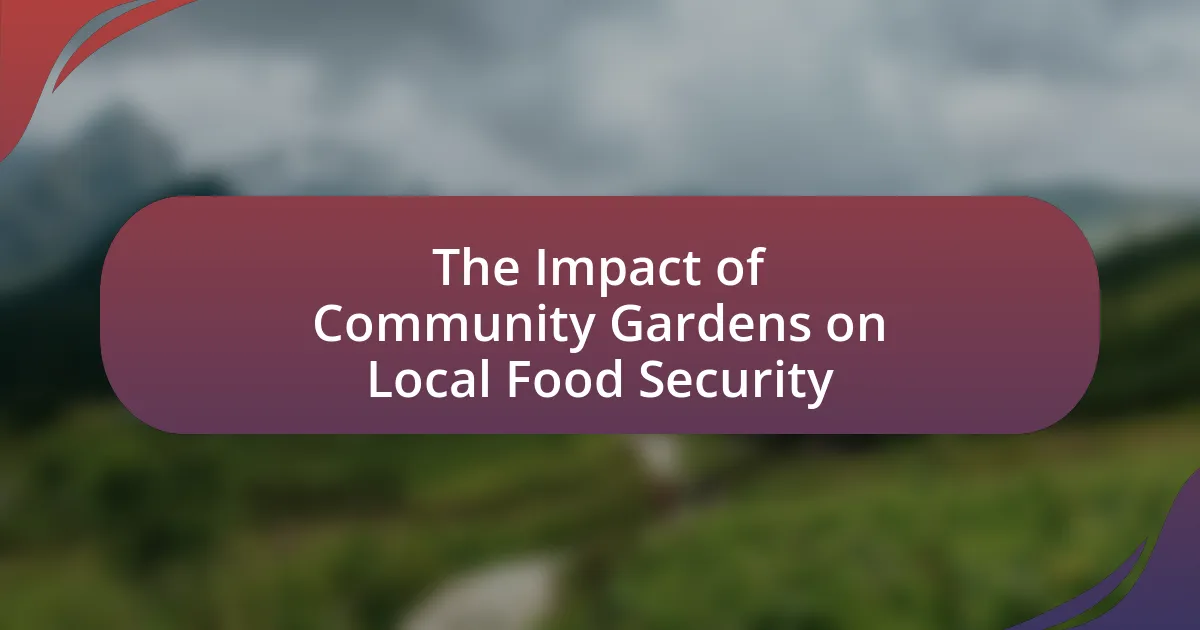Sustainable pest management strategies for community gardeners focus on integrated pest management (IPM), which combines biological, cultural, physical, and chemical methods to control pests while minimizing environmental impact. Key practices include crop rotation, companion planting, and the introduction of beneficial insects, which collectively promote ecological balance and reduce reliance on chemical pesticides. The article outlines the differences between sustainable and traditional pest management, highlights common garden pests, and discusses the benefits of sustainable practices, such as enhanced biodiversity and improved crop health. Additionally, it addresses challenges faced by gardeners and emphasizes the importance of education and collaboration in implementing effective pest management strategies.
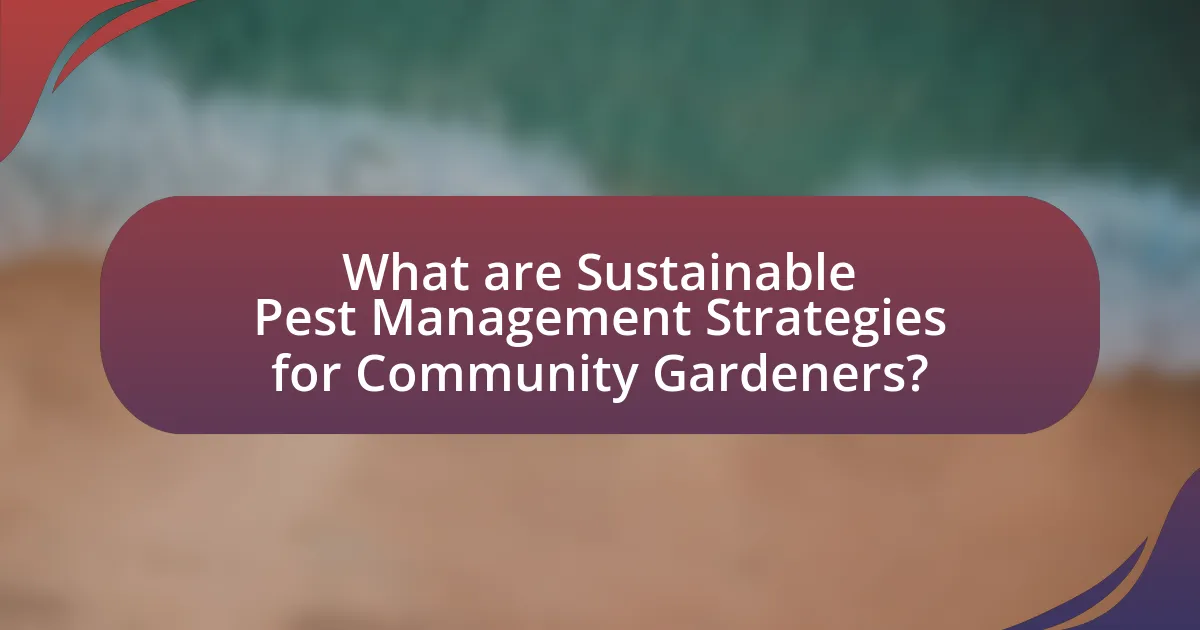
What are Sustainable Pest Management Strategies for Community Gardeners?
Sustainable pest management strategies for community gardeners include integrated pest management (IPM), which combines biological, cultural, physical, and chemical tools to minimize pest damage while reducing risks to people and the environment. Community gardeners can implement practices such as crop rotation, companion planting, and the use of beneficial insects to naturally control pest populations. For instance, introducing ladybugs can help manage aphid infestations, while planting marigolds can deter nematodes. Research indicates that IPM can reduce pesticide use by 50% or more, promoting healthier ecosystems and safer food production.
How do these strategies differ from traditional pest management?
Sustainable pest management strategies differ from traditional pest management by emphasizing ecological balance and prevention rather than reliance on chemical pesticides. Traditional pest management often focuses on immediate pest elimination through synthetic chemicals, which can harm beneficial organisms and lead to pesticide resistance. In contrast, sustainable strategies incorporate practices such as crop rotation, companion planting, and the use of natural predators, which promote long-term pest control and enhance soil health. Research indicates that these sustainable methods can reduce pest populations effectively while minimizing environmental impact, as demonstrated in studies showing that integrated pest management can lower pesticide use by up to 50% without compromising crop yield.
What are the key principles of sustainable pest management?
The key principles of sustainable pest management include prevention, monitoring, and control strategies that minimize environmental impact while effectively managing pest populations. Prevention involves practices such as crop rotation, selecting pest-resistant plant varieties, and maintaining healthy soil to reduce pest establishment. Monitoring entails regular observation and assessment of pest populations to make informed decisions about interventions. Control strategies may include biological control methods, such as introducing natural predators, and the judicious use of chemical controls only when necessary, ensuring that they are targeted and environmentally safe. These principles are supported by research indicating that integrated approaches lead to more resilient ecosystems and sustainable agricultural practices.
Why is sustainability important in pest management for community gardens?
Sustainability is important in pest management for community gardens because it promotes ecological balance and reduces environmental impact. Sustainable pest management practices, such as integrated pest management (IPM), utilize natural predators and organic methods to control pests, minimizing reliance on chemical pesticides. This approach not only protects beneficial insects and soil health but also enhances biodiversity within the garden ecosystem. Research indicates that sustainable practices can lead to a 50% reduction in pesticide use while maintaining crop yields, demonstrating their effectiveness and necessity for long-term garden health.
What types of pests are commonly found in community gardens?
Common pests found in community gardens include aphids, slugs, snails, spider mites, and whiteflies. These pests are prevalent due to the diverse plant species and the close proximity of plants in community gardens, which can create ideal conditions for pest infestations. For instance, aphids can reproduce rapidly and feed on a variety of plants, while slugs and snails thrive in moist environments, often damaging seedlings and leaves. Spider mites are known for their ability to cause significant damage by sucking plant juices, and whiteflies can transmit plant viruses, further complicating pest management efforts.
How can gardeners identify these pests effectively?
Gardeners can identify pests effectively by observing specific signs of damage, recognizing pest life cycles, and utilizing traps or monitoring techniques. For instance, visible damage on leaves, such as holes or discoloration, often indicates pest activity. Additionally, understanding the life cycles of common pests, such as aphids or caterpillars, helps gardeners anticipate their presence. Employing sticky traps can also provide visual confirmation of pest populations, allowing for timely intervention. Research shows that integrated pest management strategies, which include regular monitoring and identification, significantly reduce pest-related crop losses, supporting sustainable gardening practices.
What are the potential impacts of these pests on garden health?
Pests can significantly harm garden health by damaging plants, reducing yields, and promoting disease. For instance, aphids can weaken plants by sucking sap, leading to stunted growth and reduced flowering. Additionally, pests like spider mites can cause leaf discoloration and drop, further compromising plant vitality. Research indicates that infestations can lead to a 50% decrease in crop yields, highlighting the economic impact on gardeners. Furthermore, pests can act as vectors for plant diseases, spreading pathogens that can devastate entire crops. Therefore, effective pest management is crucial for maintaining garden health and productivity.
What are the benefits of implementing sustainable pest management strategies?
Implementing sustainable pest management strategies offers multiple benefits, including reduced environmental impact, enhanced biodiversity, and improved crop health. These strategies minimize the use of harmful chemicals, which can lead to soil and water contamination, thereby promoting a healthier ecosystem. Research indicates that sustainable practices, such as integrated pest management (IPM), can increase beneficial insect populations, which naturally control pest populations. Additionally, studies show that crops managed sustainably often exhibit greater resilience to pests and diseases, resulting in higher yields and better quality produce.
How do these strategies promote biodiversity in community gardens?
Sustainable pest management strategies promote biodiversity in community gardens by encouraging a diverse range of plant species and beneficial organisms. These strategies, such as companion planting and the use of natural predators, create a balanced ecosystem that supports various life forms. For instance, companion planting can enhance plant health and deter pests, while attracting pollinators and beneficial insects, which are crucial for maintaining ecological balance. Research indicates that gardens employing these methods can increase species richness and abundance, leading to healthier and more resilient ecosystems.
What economic advantages do sustainable practices offer to gardeners?
Sustainable practices offer economic advantages to gardeners by reducing costs associated with inputs like fertilizers and pesticides. By utilizing organic methods and natural pest control, gardeners can lower their expenditure on chemical products, which can be expensive and harmful to the environment. For instance, a study published in the Journal of Sustainable Agriculture found that organic farming can reduce input costs by up to 30% compared to conventional methods. Additionally, sustainable practices often lead to healthier soil and increased biodiversity, which can enhance crop yields over time, further improving economic returns.
How can community gardeners implement these strategies effectively?
Community gardeners can implement sustainable pest management strategies effectively by integrating practices such as crop rotation, companion planting, and the use of natural predators. Crop rotation disrupts pest life cycles and reduces soil-borne diseases, while companion planting can deter pests and enhance plant growth through beneficial relationships. For instance, planting marigolds alongside vegetables can repel nematodes and other harmful insects. Additionally, introducing natural predators like ladybugs can help control aphid populations without the need for chemical pesticides. Research indicates that these methods not only improve pest control but also promote biodiversity and soil health, making them effective strategies for community gardens.
What tools and resources are available for sustainable pest management?
Sustainable pest management tools and resources include integrated pest management (IPM) practices, biological control agents, organic pesticides, and educational materials. IPM combines cultural, mechanical, biological, and chemical methods to minimize pest damage while reducing risks to human health and the environment. Biological control agents, such as beneficial insects like ladybugs and parasitic wasps, help manage pest populations naturally. Organic pesticides, derived from natural sources, provide alternatives to synthetic chemicals, ensuring safety for both the ecosystem and consumers. Educational resources, such as extension services and community workshops, offer guidance on pest identification and management strategies, empowering gardeners to implement sustainable practices effectively.
How can gardeners collaborate to enhance pest management efforts?
Gardeners can collaborate to enhance pest management efforts by sharing knowledge, resources, and strategies for integrated pest management (IPM). Collaborative practices such as organizing workshops to educate each other on pest identification and control methods can significantly improve overall effectiveness. For instance, community gardens that implement IPM techniques have reported a 30% reduction in pest populations, demonstrating the impact of shared learning and cooperative action. Additionally, gardeners can establish a pest monitoring system where they collectively track pest outbreaks and share real-time data, allowing for timely interventions. This collaborative approach not only fosters a sense of community but also leads to more sustainable pest management outcomes.
What are some common challenges faced in sustainable pest management?
Common challenges faced in sustainable pest management include limited knowledge of integrated pest management (IPM) practices, difficulty in identifying pests and beneficial organisms, and reliance on chemical pesticides that may undermine sustainability efforts. Research indicates that many community gardeners lack training in IPM, which combines biological, cultural, and mechanical control methods to manage pests effectively. Additionally, misidentification of pests can lead to inappropriate control measures, further complicating pest management. A study published in the Journal of Agricultural and Environmental Ethics highlights that reliance on chemical solutions can lead to pest resistance and environmental harm, emphasizing the need for education and resources to support sustainable practices.
How can gardeners overcome these challenges?
Gardeners can overcome challenges in sustainable pest management by implementing integrated pest management (IPM) strategies. IPM combines biological control, habitat manipulation, and cultural practices to minimize pest impact while promoting ecological balance. For instance, introducing beneficial insects like ladybugs can naturally reduce aphid populations, while crop rotation disrupts pest life cycles, reducing infestations. Research indicates that IPM can decrease pesticide use by up to 50%, enhancing both environmental health and crop yield. By adopting these methods, gardeners effectively manage pests while supporting sustainability in community gardens.
What role does education play in addressing these challenges?
Education plays a crucial role in addressing the challenges of sustainable pest management for community gardeners by equipping them with knowledge and skills necessary for effective practices. Through educational programs, gardeners learn about integrated pest management (IPM) techniques, which emphasize the use of biological controls, cultural practices, and minimal chemical interventions. Research indicates that communities with access to educational resources experience a 30% reduction in pest-related crop losses, demonstrating the effectiveness of informed practices. Furthermore, education fosters awareness of environmental impacts, encouraging gardeners to adopt sustainable methods that protect biodiversity and promote ecosystem health.
What practical tips can community gardeners follow for effective pest management?
Community gardeners can implement several practical tips for effective pest management, including crop rotation, companion planting, and the use of natural predators. Crop rotation disrupts pest life cycles by changing the location of specific plants each season, reducing the likelihood of infestations. Companion planting involves pairing plants that can deter pests or enhance each other’s growth, such as planting marigolds alongside vegetables to repel nematodes. Additionally, introducing natural predators like ladybugs or lacewings can help control pest populations without the need for chemical pesticides. These strategies are supported by research indicating that integrated pest management techniques can significantly reduce pest issues while promoting biodiversity in garden ecosystems.
